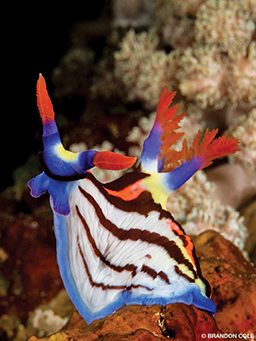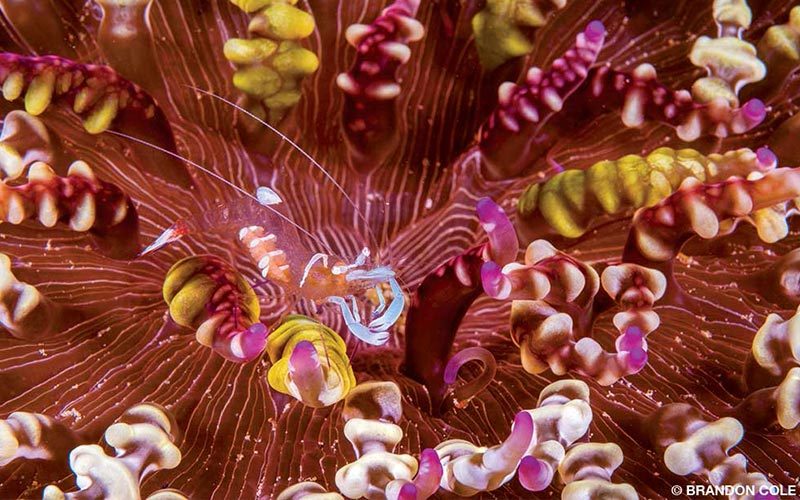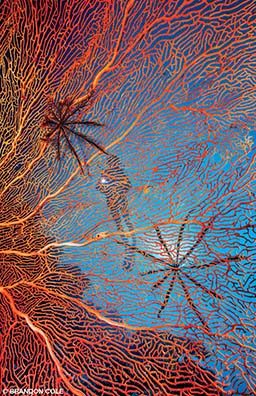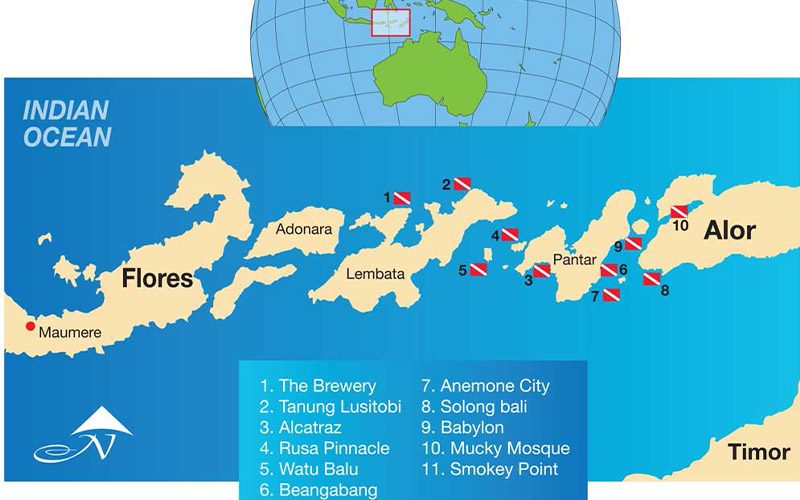I was first lured into the wilds of Indonesia almost 25 years ago. Back then this nation of 17,000 islands was truly out of sight and mind of the average American diver. Times have certainly changed; in the past decade exotic Indonesian destinations such as Lembeh Strait, Komodo and Raja Ampat have become household names for North American divers with wanderlust. But what about East Nusa Tenggara? Killer dive sites between the islands of Flores and Alor are not yet on the tips of divers’ tongues. Beangabang, anyone? How about Watu Balu? When I heard through the grapevine that a new frontier had been found, I knew it was time to rekindle the spirit of discovery and dive into the hazy unknown, somewhere East of Flores.

After a very long flight to Bali followed by a thankfully short one to Maumere on Flores’ northeastern shore, we climbed onto our liveaboard to a warm welcome by the smiling crew, many of whom we have sailed with before on previous cruises in different parts of Indonesia. We began motoring almost immediately, steaming 80 miles through the night into waters enigmatic and bright with promise.
We awaken in the Ring of Fire surrounded by volcanoes near and far. Their flanks ramping sharply up into the morning blue, they loom over the green folds of eastern Flores, Adonara and Lembata islands. Their presence is greatly appreciated, for we know that beneath us await some of the world’s richest coral reefs. The thousands of species of fish and invertebrates thriving here in the heart of the Coral Triangle owe their existence to the region’s volcanic origins. We have come to the epicenter of marine diversity, and we are keen to dive into this cauldron of creation.
Armed with macro lenses, we submerge to taste the waters at The Brewery. Poking along this shallow sandy slope off Lembata Island, we find weird and wonderful critters aplenty: a wonderpus showing off, a bright-yellow winged pipefish, psychedelic nudibranchs, leaf fish and a bold peacock mantis shrimp on walkabout. At night the action heats up with squid following us around, creepy devil scorpionfish and stargazers, a variety of crabs and so much more lurking in the shadows. This easy and productive site is one of many excellent muck dives on our 13-day itinerary. During dinner and the first of many slideshows we learn it was discovered by Aussie shark-diving legend Valerie Taylor.
Also on Lembata Island is Tanjung Lusitobo, which was recently discovered by our boat’s team, pioneers who have logged extensive time between Flores and Alor. This wall dive is offshore of a rugged coastline, gorgeous in a Jurassic Park sort of way. Palms perch above craggy volcanic rocks. Swirling, surging whitewater crashes against the base. Below the surface we find a multicolored jigsaw puzzle of convoluted leather corals and then a wall that shelves down from 50 to 130 feet. Big trees of green Tubastrea cup corals sprout among barrel sponges and sprays of sea fans, crinoids and gorgonians. A jumbled mix of fish swarm the reef and compete for my attention. I cannot decide which to follow with my wide-angle lens — the parade of bannerfish, the cloud of orange anthias or the school of sleek unicornfish. The photo opportunities are almost overwhelming. It’s a good problem to have.

While some guests prefer to nap between dives, others choose more active pursuits, which our cruise directors are pleased to provide. On offer are beach walks, kayaking and special cultural tours in which we can meet some of this country’s fascinating and friendly people. My special request is a stop at the village of Lamalera on Lembata’s southern shore, which looks out into the Savu Sea. This community of 2,500 people represents one of the last traditional whaling cultures on earth. The men still hunt sperm whales by hand, leaping overboard from small wooden boats to drive an iron-tipped bamboo harpoon into their prey. They use traditional methods and gear to harvest 15-30 sperm whales annually. Every part of the animal is used, and what meat the villagers do not consume is used to barter with other villages for rice and vegetables. Lamalera has been sustainably hunting sperm whales in this manner for more than 500 years. The people are categorized as aboriginal hunters and are exempt from the International Whaling Commission’s moratorium on the killing of whales. Our morning spent visiting Lamalera’s people to better understand their unique way of life and appreciate their connection to these rich waters ranks as one of the trip’s highlights for me.

We are only a few days into our cruise, and it is already one of the most memorable working holidays I’ve had in a long, long time. The diversity of marine life and marine habitats as well as the variety of topside activities are remarkable and ensure we will not forget this adventure anytime soon.
How could we, with dives like Alcatraz, Rusa Pinnacle and Watu Balu? We weave through selats (straits) that bridge the Indian and Pacific oceans, around batus (rocks) and past pulaus (islands) in our march eastward to Alor. Pantar, the next major island we encounter, showcases many of East Nusa Tenggara’s top scuba sites. Our divemaster guides my wife, Melissa, and me down to a forest of 3-foot-tall burgundy-colored soft-coral trees at Alcatraz. Emerging from the sand at 90 feet, they create an otherworldly landscape, bizarre and beautiful, reminding me of the “upside down” baobab trees in Madagascar.
Rusa Pinnacle, very rarely dived, proves to be one of most challenging submersions of the itinerary. The current gives us a workout, but the reef scenery from the slope at 100 feet all the way up to the pinnacle’s peak in 20 feet makes it all worthwhile. Purple hydrocorals and bubblegum-pink cup corals seem to explode off the reef with their brightness. A variety of angelfish species, emperors, damsels, bannerfish and legions of anthias hug the healthy hard corals and sea fans, while the current whooshes us along. Barracuda, sinister sneering dogtooth tuna and even a Mola mola tempt us out into the blue, but the current says no.
Another nearby secret spot for advanced divers is Watu Balu, which delivers even more excitement, current, cool upwellings and surge so strong we feel like we are in the world’s most colorful washing machine. My logbook reads:
Insane dive. And favorite so far! Wild and wooly conditions. Boiling at the surface. Fish soup below. A maelstrom of fish flesh: fusiliers, surgeons, billions of anthias, all feeding in the plankton storm. Current cranking sideways, up, down, spinning us around. Mammoth surge. Tunas and GTs massacring the baitfish. Glorious chaos and mind-boggling color. Terraces of perfect table corals, like Bali’s rice terraces. No way photos will do this place justice. Killer site!

So good is Watu Balu that even with the difficult conditions we beg the crew for a second jump. They agree, commenting that this amazing rock has probably been dived by only a few dozen people, in part because of its remote location and in part because of the tough conditions. The profusion of life, the kaleidoscope of eye-popping colors created by innumerable anthias buzzing over pristine hard and soft corals, and the raw kinetic energy of the waters around us make me wonder whether this is what the primordial seas were like long before man entered the picture.
The diving East of Flores is not all hurricane-strength current and stomach-lurching surge. Relaxing, 90-minute submersions by day and night over the black-sand slope off Beangabang beach on Pantar’s southeast side unveil a wealth of little beasties. We spot coconut octopus, mating bubble shells, juvenile lionfish and hellfire anemones with harlequin crabs. A spiky cluster of sea urchins provides protection for juvenile bannerfish and cardinals. Ghost pipefish and frogfish hide in plain sight. Surface intervals between our three dives at Beangabang are filled with fun photo shoots of the namesake village’s children, who paddle out in dugout canoes to see us.

The Pantar Strait connects two oceans, the Pacific to the north and the Indian to the south. We devote two days to exploring this dynamic waterway above and below Pantar’s waterline, starting with a search for cetaceans. Though we do not encounter any of the mighty blue whales or sperm whales that are often sighted migrating through these productive waters, we do luck out with playful pods of both spinner and Fraser’s dolphins. We dive Pura Island’s Anemone City, truly Nemo’s kingdom with more carpet anemones and Clark’s anemonefish than I’ve ever encountered before in my life, and Solong Bali, where we follow fishlike kids with homemade goggles and rudimentary spearguns as they hunt on their shallow reef. At Babylon, adjacent to Reta Island, we drift over a hard-coral garden to see the locals’ handcrafted fish traps and then witness thousands of convict blennies emerging from their communal burrow like liquid mercury to move as one over
the reef.

Alor Island marks the turnaround point for our expedition. But before we point the bow westward, our group votes for another surf and turf day, beginning with an early morning visit to the lively fish, fruit and vegetable market in Kalabahi followed by a drive into the highlands to the village of the Aboi hill tribe. Headhunters in the not-so-distant past, the Aboi now welcome guests and are proud to share their culture through traditional song and dance. A few brave souls in our group join them in chewing betel nut.
My excuse for abstaining is that I have to keep taking pictures of the ceremony (and keep a clear head for the afternoon and evening dives at Mucky Mosque). My favorite muck dive of the cruise, this site along the northern shore of Kalabahi Bay is aptly named. It is a steep sand/mud/rubble slope directly in front of a mosque. The cast of characters drawn to this mecca is truly impressive. As is always the case, our expert guide deserves most of the credit for “our” discoveries. His superhuman eyes spy blue-ringed and wonderpus octos, iridescent bobtail squid, a rare dottyback species, zebra crabs, frogfish and many spectacular sea slugs — all within a few minutes. My brain cannot process all of the photographic possibilities. But I redeem myself by finding my own paddleflap scorpionfish, splendid in red with its shaggy eyebrows and pectoral fins flared out like frilly Japanese fans.

At dinner that night, while folks are excitedly reliving the magnificent mucking about, the captain gives us the news that we will now head west and north, way out into the Flores Sea. The weather and the moon, that fickle mistress who pulls the tides to and fro, are finally giving us an opportunity to sail to Komba. We settle in for a long night’s steam.
A thunderous crack and boom shatters the silence, interrupting our 7 a.m. dive briefing. Heads snap around to stare upward at a billowing ash plume mushrooming into the early morning sky. With a smile, our cruise director continues with a deadpan, “Welcome to Komba Island. Maybe we’ll hear the next eruption while we’re underwater.”
It’s something for us to contemplate as we gear up, trying to focus on buddy checks and analyzing our nitrox mixes rather than imagining rivers of magma and projectiles of mountainside descending from an ash-clouded sky. The water at Smokey Point is warm at 82°F but not as hot as the superheated seawater of my nightmares, in which I’m boiled alive like a neoprene-clad lobster. In no time at all, I’ve stopped worrying about the eruptions that occur every 15 minutes and am instead contentedly stalking fish — snappers, squarespot anthias, yellow damsels and garden eels — and setting up wide-angle shots of the vibrantly hued sea fans and soft corals. Blue starfish cling to the pretty coral formations that flourish in the shallows. Tuna streak by in the blue. I decide that the submerged shoulders of a grumbling volcano is a lovely place to dive. I’m happy and at peace within the Ring of Fire, deep beneath the waves in the wilds of Indonesia.
How to Dive It
Conditions: You can dive Flores to Alor year-round. The dry season is May through November; the rainy season is December through April. The air temperature ranges from 80°F to 90°F. Seawater temperature averages 80°F, though there are often cooler upwellings (down to 70°F) at some southern dive sites in the Savu Sea. Underwater visibility varies from 30 feet to more than 100 feet.

Skill level: Dive sites range from novice to advanced depending on the depth and current. Surface signaling devices are a great idea. Pay close attention to the briefings, and dive within your limits. Remember that you are exploring a remote area without big cities or advanced medical care. Dive conservatively. The nearest hyperbaric chamber is in Bali.
Getting there: Fly to Bali (airport code DPS) and then to Maumere (MOF). This town of approximately 100,000 people on Flores Island is the port of departure for liveaboard voyages sailing east to Alor and back through the Indian and Pacific oceans. A 10- to 15-night cruise is highly recommended to provide enough time to zig and zag between the islands and pause for topside treks as well. There are also a few land-based diving resorts in the Alor Archipelago.
© Alert Diver — Q3 Summer 2016